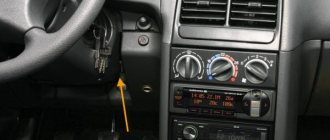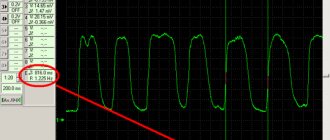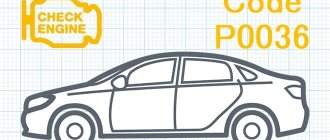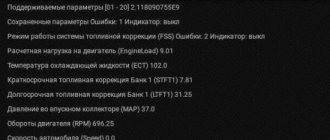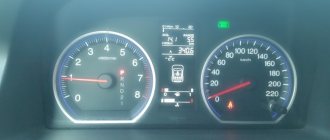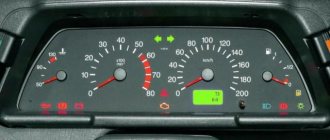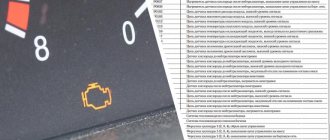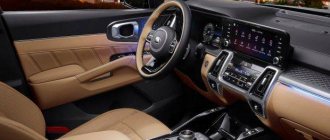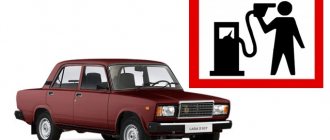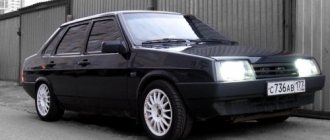17.01.2018
11726
Cars, Repair
What is a "lean mixture"? This is an air-fuel mixture containing a LOT of air and a LOT of gasoline. Based on this information, you need to start looking for the causes of error P0171.
Let's start with the first one - too much air. Injection vehicles are equipped with air flow meters (MAF or DAMV). It is installed immediately after the air filter and counts all the air that is sucked into the intake manifold to form the air-fuel mixture. Based on the readings of this sensor, the controller knows how much air has passed and how much gasoline it needs to supply for a given amount of air.
If excess air enters the intake manifold, not taken into account by the flow meter, then there will be more air and, as a result, we get a lean mixture . The most difficult thing is that it is quite difficult to find where exactly this unaccounted air is sucked in.
The main places for air leaks are the intake manifold gasket, throttle body gasket, corrugation from the filter to the throttle body, IAC, injector O-rings, vacuum brake booster, canister valve.
And now we’ll look at 3, in my opinion, the most effective methods for finding air leaks into the intake manifold.
Technical description and interpretation of error P0171
This diagnostic trouble code (DTC) is a generic powertrain code. Trouble code P0171 is considered a common code because it applies to all makes and models of vehicles. Although the specific repair steps may vary slightly depending on the model.
To operate correctly, the engine must add the right amount of fuel to the amount of incoming air. The correct air-fuel ratio is essential for optimal power and fuel efficiency.
The engine control unit (ECU) uses a number of sensors to determine the amount of fuel that needs to be added. Most often, the ratio of air and fuel in the mixture is determined based on the readings of oxygen sensors by calculating the amount of oxygen and carbon monoxide in the exhaust gases.
The most optimal ratio of air and fuel in the mixture supplied to the engine cylinders is 14.7:1. It is this ratio that is necessary to achieve maximum engine power and optimal fuel consumption.
During normal operation, the ECU monitors the balance between rich and lean mixture. Simultaneously monitoring short-term and long-term fuel balance (STFT and LTFT). Typically the fuel adjustment is 3% of the ideal value. This depends on the current air temperature, coolant and load.
Engine problems such as high fuel pressure, a distorted MAF signal, or a faulty fuel injector can increase fuel consumption. Due to these problems, incorrect airflow data is received, which will result in corrupted data.
The ECU will try to compensate for the imbalance in the fuel mixture. If the control module fails to maintain the 14.7:1 ratio, it will trigger DTC P0171 - Fuel Mixture Too Lean (Bank 1).
Where does the excess air come from?
The most likely places for air leaks:
- The corrugation going from the air filter to the throttle assembly, microcracks may appear on it, through which excess air will leak
- Intake manifold gasket;
- Gasket between intake manifold and throttle body;
- Vacuum brake booster and its hose;
- O-rings for injectors;
- Canister valve (connected to the throttle body);
- Idle speed control
However, before you look for leaks in these nodes, let's try some tricks. Below we will look at ways to fix the air leak and accordingly get rid of the P0171 code.
Method 1
To look for a leak, you must first make sure that there really is a leak. Warm up the engine (this is not necessary, but recommended). To do this, unscrew the flow meter from the air filter and pull it out.
This thing should stick out. There is no need to disconnect it from the corrugation!
Start the engine. Make sure that it is operating normally and while it is operating, close the air inlet into the engine tightly with your hand or some other device. This needs to be done as tightly as possible so that there is no suction. After you have tightly closed the inlet, the corrugation may shrink and the engine should stall. Don't remove your hand, keep it tight. After the engine has stalled, listen carefully for air leaks.
If the engine has already stalled, the corrugation remains in the compressed position for a long time, there is no hissing, which means there is no air leakage.
Method 2
You need to take some kind of fuel (gasoline, ether, WD, carburetor cleaning fluid), etc. Gasoline and ether are most preferable, since they are more “native” to the engine. Pour the liquid into a spray container or use a standard one (for example, a sprayer on a WD). Start the engine. Spray all connections of the intake manifold (all gaskets, rubber bands, corrugations).
If any of the connections are leaky, liquid will certainly enter the air-fuel mixture and cause changes in engine operation (they will become either larger or smaller). If the engine does not react at all, then everything is in order with the connections. If the engine has changed its operation, we can say that you have already found the problem.
Method 3
The third method of detecting suction requires a smoke generator. You can make it yourself or ask friends/rent it. On the Internet you can find many options for making a smoke generator using improvised means, so, in principle, this option is not so difficult if you have enough desire and two hands.
Let's assume that you already have a smoke generator. What to do next? Start it and start the engine. Direct a stream of smoke into the corrugation, which sucks in air. If there are leaks in the intake manifold, you will definitely see them in the form of smoke coming out.
The simplest smoke generator can be made from a bottle and a cigarette
You can easily find detailed information on the Internet.
Symptoms of malfunction
The main driver symptom of P0171 is the MIL (Malfunction Indicator Light). It is also called Check engine or simply “check light”.
They can also appear as:
- The “Check engine” warning light on the control panel will light up (the code will be stored in the ECM memory as a malfunction).
- Floating speed, the car engine may operate unstably.
- Decrease in engine power.
- The engine stalls or has trouble starting.
- Increased fuel consumption.
- Possible misfires in the engine cylinders.
The severity of the P0171 code is higher than average, so it is recommended to fix the problem as soon as possible. Most likely, with this problem, you will be able to continue your trip, but fuel consumption will increase. And due to poor fuel combustion, problems with the catalyst are possible in the future.
Reasons for the error
Code P0171 may mean that one or more of the following problems have occurred:
- The mass air flow (MAF) sensor may be dirty or damaged.
- The air filter is dirty or contains oil.
- Possible vacuum leak.
- Fuel pressure problem.
- Damage to the fuel injector.
- Worn spark plugs.
- The fuel pump check valve may have failed.
- The PCV valve is leaking or has failed.
- The EGR valve may be stuck.
- Faulty oxygen sensor (Bank 1, Sensor 1)
- EVAP valve leaking.
How to Troubleshoot or Reset Trouble Code P0171
Some suggested steps to troubleshoot and fix error code P0171:
- Inspect all vacuum and PCV hoses, replace if necessary
- Clean the mass air flow sensor. It's best to remove it and clean it with electronics cleaner or WD. Be careful not to damage the MAF sensor, make sure it's dry before reinstalling.
- Inspect the fuel lines for cracks, leaks, or pinches.
- Check the fuel rail pressure.
- Check the fuel injectors; they may be dirty. Use fuel injector cleaner or have them professionally cleaned/replaced.
- Make sure there is no exhaust leak before the first oxygen sensor.
Changing the fine filter
The process of replacing this component in the Lada Kalina is a very simple action and is also included in the maintenance regulations. The most significant condition is to provide access under the bottom of the car, to where the filter itself is located, which may require a lift, overpass or pit.
How to remove the old filter? As a tool, you can arm yourself with a regular screwdriver. This operation will take a maximum of about forty minutes.
Information! Some modifications of the “Kalina” (for example, “1119”, “1186”, “21126” and “21127”) provide for fastening the filter component housing with a bolt, therefore, we can safely “change” the screwdriver to a wrench with a dimension of “10” .
1. At the very beginning of our “operation” we relieve the pressure present in the fuel circuit. For this purpose, we open the pump power circuit. This action can be accomplished in two ways:
- we take out the fuse with the number “F21”, located under the tunnel cover near the gearshift lever (to remove the cover you will need a screwdriver with a flat blade);
- disconnect the connector of the fuel pump itself, which is located under the rear seat cushion; here you will need to unscrew the 4 screws of the cover and after removing it, access to the connector will be provided.
Advice! We recommend using this method if it is necessary to replace the coarse filter component.
After turning off the pump, we start the Lada Kalina engine and wait for the fuel to be exhausted from the line, after which we observe a natural stop of the engine.
2. The filter itself is located under the tank and in most versions is secured with a plastic clip.
3. Before dismantling the filter, you will need to disconnect the fuel pipes, also secured with clamps. They should be disconnected, after which the filter can be freely removed.
Attention! The filter, which is fixed near the tank using a combination of clamp-bolt fasteners, is dismantled using a wrench of the specified standard size.
4. Installation of the new element (its catalog code is “2190-1117010”) on the LADA Kalina car is carried out between the provided stops and following the reverse dismantling algorithm.
5. We put the previously removed fuel pipes onto the corresponding fittings until the characteristic click of the clamps is felt.
New Lada: Auto electrics, electrics, diagrams, garage - Electrical diagram of VAZ-11183 Kalina cars
Important! We carefully examine the surface of the filter housing and find a schematic arrow on it, which on the installed component should be oriented towards the direction of fuel supply.
6. Make sure that the specified fasteners are securely fixed and return the fuse marked “F21” to its original place (or connect the cable harness to the pump block and install the cover).
7. Start the engine. Here you will need several correct actions:
- turn the ignition on and off immediately several times in a row;
- wait a pause to allow the pump to pump fuel into the line;
- finally start the engine.
Now you know how to change the fuel filter in a car.
When the unit does not fully start on the first try, we repeat this procedure again. This is necessary for the pressure in the fuel supply system to reach its operating value.
Diagnosis and problem solving
A dirty MAF sensor can skew air intake measurements and therefore skew fuel injection calculations. Next, check the fuel pressure to make sure it is in the correct range. Excessive pressure, due to a faulty pressure regulator or a compressed line tube, will cause more fuel to be injected than the ECU expected.
Check that the ECT and IAT (inlet air temperature) readings are correct. The ECU can pick up blocked sensors, so it's good to check that the ECT and IAT readings are within the normal range.
For example, if the engine is running for half an hour on a hot day, the ECT should show a temperature of about 80°C. If it still reads 0°C, the ECU will richen the air/fuel mixture to compensate, resulting in a rich condition.
Reduced fuel pressure
With the engine running, record the fuel pressure, and then stop the engine. Fuel pressure may drop slightly but should remain stable for at least 10 or 15 minutes.
If fuel pressure continues to drop, you may have a leaking fuel injector, which will result in a rich and possibly non-ignitable condition.
Valve blocking
A faulty valve in the cylinder head dumps unburned fuel into the exhaust gas stream. Check and correct this problem before attempting to correct a rich air/fuel mixture error.
Pay attention to other trouble codes that may be present at the same time as P0171. For example, for VVT (variable valve timing) or ignition system.
Traffic fumes
Check the exhaust system for leaks, especially in front of the first O₂ sensor. Damage can be mechanical, in the form of cracks, or caused by corrosion.
The entry of atmospheric air before this sensor can distort the oxygen content measurements. At the same time, the ECU will try to compensate the mixture and add fuel.
Over-lean mixture of VAZ 2114
Before studying the reasons for a lean mixture on an injector, it is probably worth understanding what a lean mixture means (in the very concept), and how this, in principle, threatens the car. However, it is worth knowing the signs of excessive impoverishment, identifying the reasons (unless this was not intended) and being able to deal with them, if in your immediate plans the first item is not a serious repair of the car or even replacing it.
The reasons, by the way, are not so varied, and eliminating them is often quite simple. The main thing is to understand what is happening to your car and take action before it gets offended at you and completely refuses to drive, and your nerves become completely unusable.
Why is she poor?
The reasons for a lean mixture on the injector, as already mentioned, are quite trivial. Anyone who has an engine with an injector in their car knows that it can regulate the ratio of gasoline vapors to air. However, not everyone thinks about the correct balance. For people who are not inclined to go into technical details, we explain: the norm is the proportion of a kilogram of those same vapors per 15 kilograms of air.
It maintains parity between economical consumption and engine power. If the weight of air is reduced to 13 kg, there will be more gasoline, the engine will gain more power, but fuel consumption will also increase significantly.
In the opposite situation (often allowed with full consciousness of what is being done), when air is introduced in an amount of 16 kg, the power drops by 10 percent compared to an enriched mixture, but the savings increase by 15-20%. However, further dilution of gasoline leads not only to a decrease in engine thrust, but also to an increase in consumption: trying to crawl up some hill, you press on the gas, burning more fuel, and efficiency is zero.
Therefore, no one sets the injector to 20 kilos of air per 1 gasoline. That is, there are some problems with the node itself.
Signs of impoverishment
The main and main symptom of a lean mixture is a stalling engine. A very weak mixture leads to the fact that the engine does not start at all, and if it starts, then when you try to move, it immediately runs out of steam. It’s just that the mixture is not rich enough and the car jumps and moves jerkily when driving. However, this driving style is not only characteristic of a lean mixture.
A car can behave this way even if it has problems with any part of the ignition - coils, spark plugs, distributor cap, cables, coal or slider. Therefore, we need to look at other, indirect or less noticeable signs. Experienced drivers recommend the following.
Turn out the candles and look at their color
. If they are light brown, the injector is working properly; dark - not enough air; light – its excess. However, carbon deposits cannot serve as an accurate indicator - its shade does not correspond to the norm both when the ignition is set incorrectly and when there are errors in the selection of the spark plugs themselves. Read the article “How to check spark plugs” for more information.
Shooting or popping noises in the muffler. If the mixture is lean, the muffler emits an automatic burst without strong recoil; if the mixture is too rich, it produces separate, noticeable explosions.
Individually, the symptoms may indicate various flaws, but collectively, they may indicate problems with the injector. Ideally, of course, it would be worth picking up a gas analyzer, but few people have one lying around on a shelf in the garage.
Factors causing impoverishment
There are only 3 of them, and we will look at each in detail.
- The most common is dirt. It clogs the injectors and filters, resulting in insufficient fuel supply to the engine;
- Extraneous air leak. Either a crack has appeared in one of the hoses and pipes connected to the manifold, or it itself has become depressurized, or some connections are poorly tightened;
- The fuel pump died quietly. Or it’s still alive, but works at a quarter of its strength, which means it will have to be changed anyway.
Speaking of dirt
. If your injector has mechanical injection, then it may also clog the pressure regulator. As a result, the backlash on the dosing plunger increases. Dosing channels and mesh filters also become clogged with dust and debris (this is also true for injectors with electronic-mechanical injection).
Whatever the reasons for the poor mixture on the injector, they must be eliminated immediately - if you want to drive your car, and not wander around it when it stops, stalling on a long journey.
Source: https://kalina-2.ru/remont-vaz/pereobednennaja-smes-vaz-2114
On which cars is this problem most common?
The problem with code P0171 can occur on different machines, but there are always statistics on which brands this error occurs more often. Here is a list of some of them:
- Audi (Audi a3, Audi a4, Audi a6, Audi q5)
- BMW (BMW X3, BMW X5, E39, E46, E53, E60, F10)
- Cadillac (Cadillac SRX)
- Chery (Chery Amulet)
- Chevrolet (Chevrolet Aveo, Camaro, Captiva, Cobalt, Cruz, Lacetti, Silverado, Spark, Trailblazer, Epica)
- Chrysler (Chrysler Voyager, PT Cruiser, Sebring)
- Citroen (Citroen C4)
- Daewoo (Daewoo Gentra, Lanos, Matiz, Nexia)
- Dodge (Dodge Caravan, Ram, Stratus)
- Fiat (Fiat Albea)
- Ford (Ford Galaxy, Kuga, Maverick, Mondeo, Taurus, Focus, Fusion, Expedition, Explorer, Escape, F-150)
- Honda (Honda Accord, Pilot, SRV, Fit, Civic)
- Hover
- Hummer H3
- Hyundai (Hyundai Getz, Santa Fe, Sonata, Tucson, Elantra)
- Infiniti (Infiniti fx35)
- Isuzu (Isuzu Rodeo)
- Jaguar
- Jeep (Jeep Grand Cherokee)
- Kia (Kia Carnival, Rio, Sid, Sorento, Spectra, Sportage, Cerato)
- Land Rover (Land Rover Range Rover, Freelander)
- Lexus (Lexus gx470, ls430, lx470, rx300, rx330, rx350)
- Lifan (Lifan x60)
- Mazda (Mazda 3, Mazda 6, Mazda cx5, Mazda cx7, Demio, Premasi, Tribute, Surname, MPV)
- Mercedes (Mercedes w203, w211)
- Mitsubishi (Mitsubishi Outlander, Galant, Delica, Lancer, Montero, Pajero)
- Nissan (Nissan Avenir, Hell, Almera, Bluebird Silphy, Vingroad, Beetle, Qashqai, Cube, Maxima, March, Micra, Murano, Note, Primera, Sunny, Serena, Teana, Tiida, X-Trail)
- Opel (Opel Antara, Astra, Vectra, Zafira, Insignia, Corsa, Meriva, Mokka)
- Peugeot (Peugeot 207, 307, 308, 408, Partner)
- Pontiac (Pontiac Vibe, Montana)
- Ravon (Ravon P4)
- Rover
- Saab
- Seat
- Skoda (Skoda Yeti, Octavia, Superb, Fabia)
- Ssangyong (Sangyong Kyron)
- Subaru (Subaru Outback, Impreza, Legacy, Tribeca, Forester)
- Suzuki (Suzuki Vitara, Grand Vitara, Ignis, Liana, Swift, sx4)
- Toyota (Toyota Avensis, Auris, Vitz, Vish, Ipsum, Camry, Corolla, Land Cruiser, Matrix, Passo, Platz, Prado, Prius, Rav4, Celica, Sienna, Tundra, Fielder, Funcargo, Highlander, Estima, Yaris)
- Volkswagen (Volkswagen Bora, Golf, Jetta, Caddy, Passat, Polo Sedan, Touareg, Tiguan)
- Volvo (Volvo s40, s60, s80, xc90)
- VAZ 2107, 2109, 21099, 2110, 2112, 2114, 2115
- Volga Cyber
- Gazelle
- Lada Vesta, Granta, Kalina, Largus, Niva, Priora
- Tagaz Tager
- UAZ Bukhanka, Patriot, 409
With fault code P0171, you can sometimes encounter other errors. The most common ones are: P0100, P0106, P0130, P0131, P0132, P0134, P0137, P0172, P0174, P0175, P0300, P0302, P0303, P0327, P0420, P0422, P0441, P1101, P1130, P201 5, P2187, P2195, C1201 , U1001.
